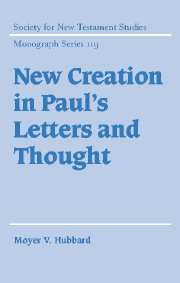Book contents
- Frontmatter
- Contents
- Acknowledgments
- List of abbreviations
- 1 Introduction: the current debate
- PART I NEW CREATION: CENTRAL JEWISH TEXTS
- Part II FROM DEATH TO LIFE: NEW CREATION IN THE CONTOURS OF PAUL'S THOUGHT
- 5 From death to life: insights from cultural anthropology
- 6 Newness of life: Romans 6.1–11
- 7 Newness of the Spirit: Romans 7.1–6
- 8 Spirit, newness, life: the Pauline antecedents
- 9 Crucified with Christ: Galatians 2.19–20
- Part III THE OLD AND THE NEW: NEW CREATION IN THE CONTEXT OF PAUL'S LETTERS
- References
- Index of passages cited
- Index of modern authors
5 - From death to life: insights from cultural anthropology
Published online by Cambridge University Press: 02 December 2009
- Frontmatter
- Contents
- Acknowledgments
- List of abbreviations
- 1 Introduction: the current debate
- PART I NEW CREATION: CENTRAL JEWISH TEXTS
- Part II FROM DEATH TO LIFE: NEW CREATION IN THE CONTOURS OF PAUL'S THOUGHT
- 5 From death to life: insights from cultural anthropology
- 6 Newness of life: Romans 6.1–11
- 7 Newness of the Spirit: Romans 7.1–6
- 8 Spirit, newness, life: the Pauline antecedents
- 9 Crucified with Christ: Galatians 2.19–20
- Part III THE OLD AND THE NEW: NEW CREATION IN THE CONTEXT OF PAUL'S LETTERS
- References
- Index of passages cited
- Index of modern authors
Summary
Everywhere we decipher the same mystery of death to the secular condition, followed by resurrection to a higher mode of being.
Mircea Eliade, Images and Symbols“Death” and “life” constitute, arguably, the most fundamental categories of human existence. Not surprisingly, they occur with predictable regularity in religious symbolism from culture to culture. The goal of this introductory section is to provide the backdrop against which Paul's death–life statements gain fullest clarity. Specifically, I will demonstrate the importance of interpreting this symbolism within the broader category of “life-crisis rituals,” which anthropologists and ethnologists have scrutinized and evaluated for nearly two centuries. Situating Paul's symbolism within this larger, universal pattern of symbolic expression will serve to orient the exegesis of the relevant texts, while also providing a methodology for interpreting Paul's religious symbolism generally. Specialists in the phenomenology of religion can offer valuable help to New Testament exegetes in the interpretation of religious imagery. Where exegetes atomize, comparative religionists synthesize. Both are crucial, but if exegetes neglect the whole, their understanding of the parts is likewise diminished.
Rites of passage
The work of Arnold van Gennep
The name of Arnold van Gennep is virtually synonymous with rites of passage. His seminal study of the subject early in the twentieth century was both ground-breaking on the theoretical level, and noteworthy on the popular level: it is one of only a handful of technical monographs which can claim to have established a popular idiom in a variety of languages. The genius of this contribution lies in its simplicity and comprehensiveness.
- Type
- Chapter
- Information
- New Creation in Paul's Letters and Thought , pp. 79 - 90Publisher: Cambridge University PressPrint publication year: 2002



